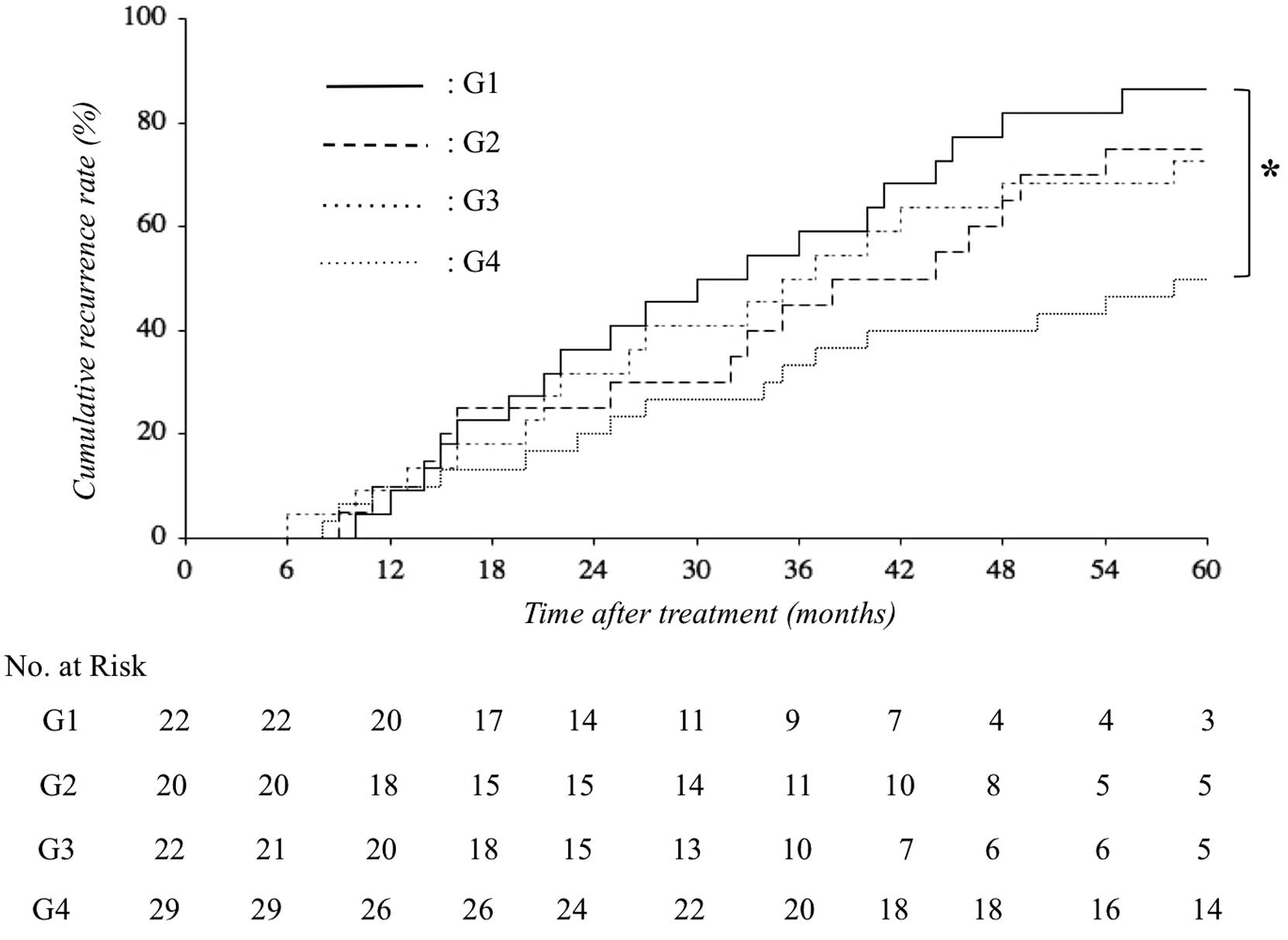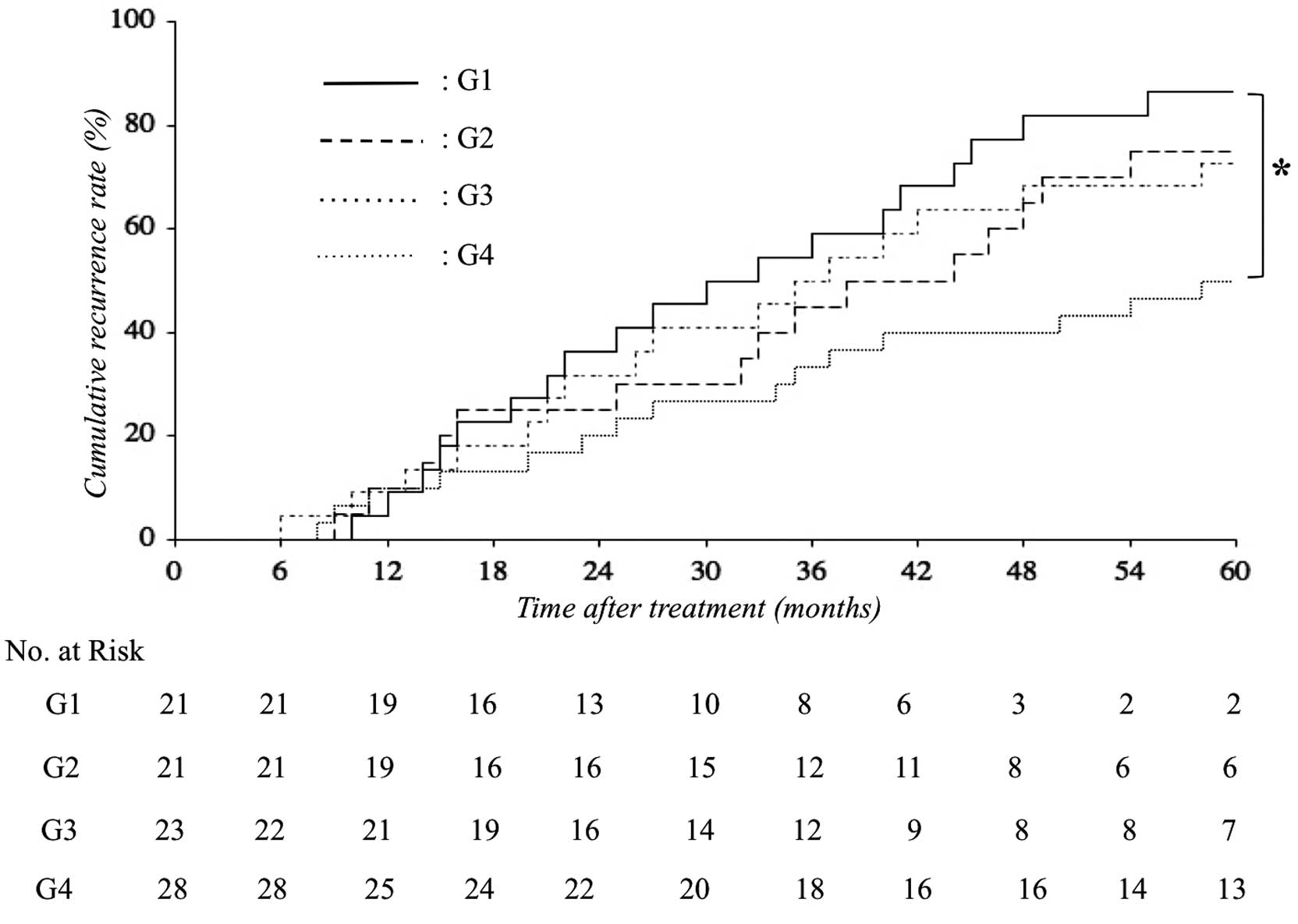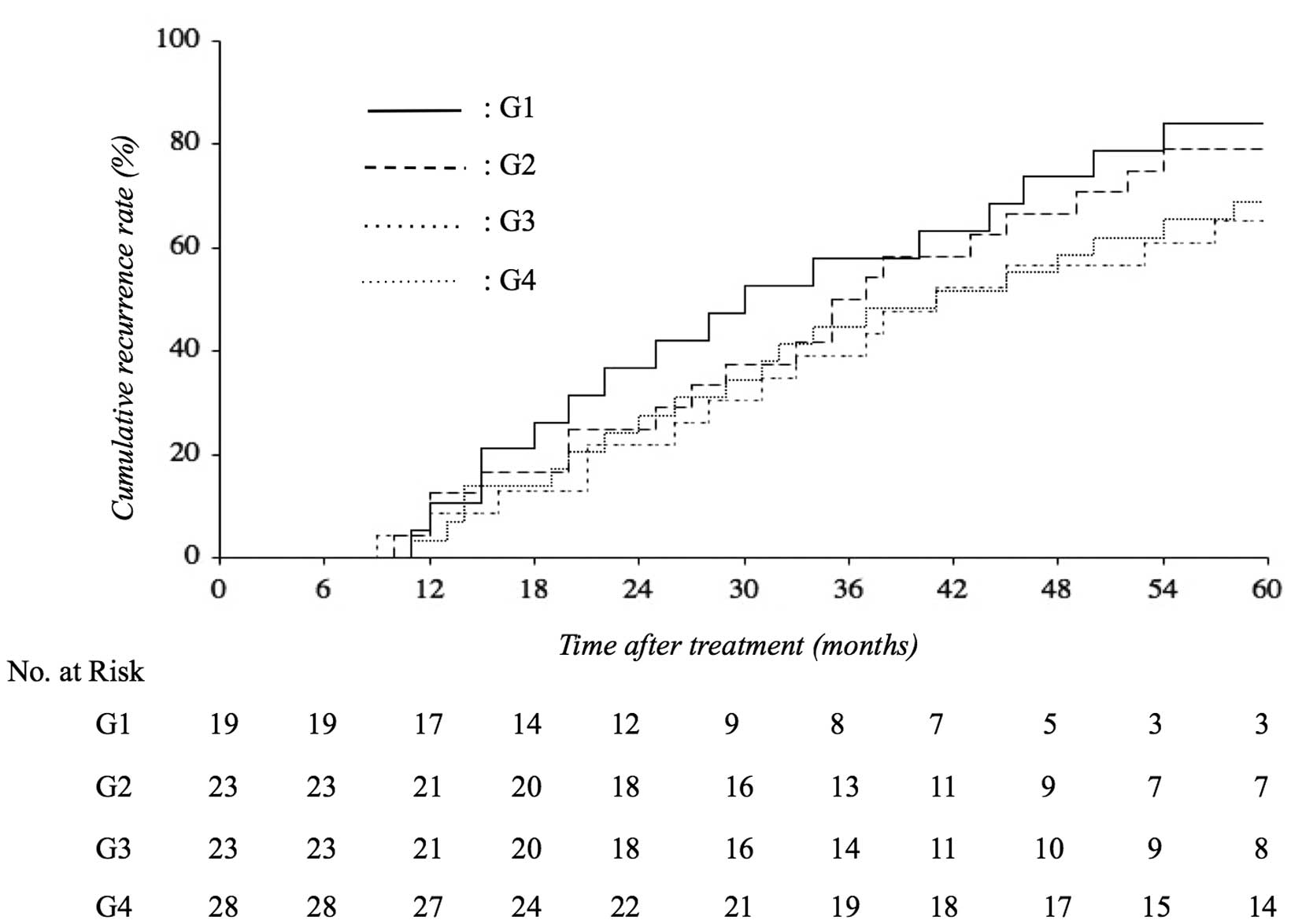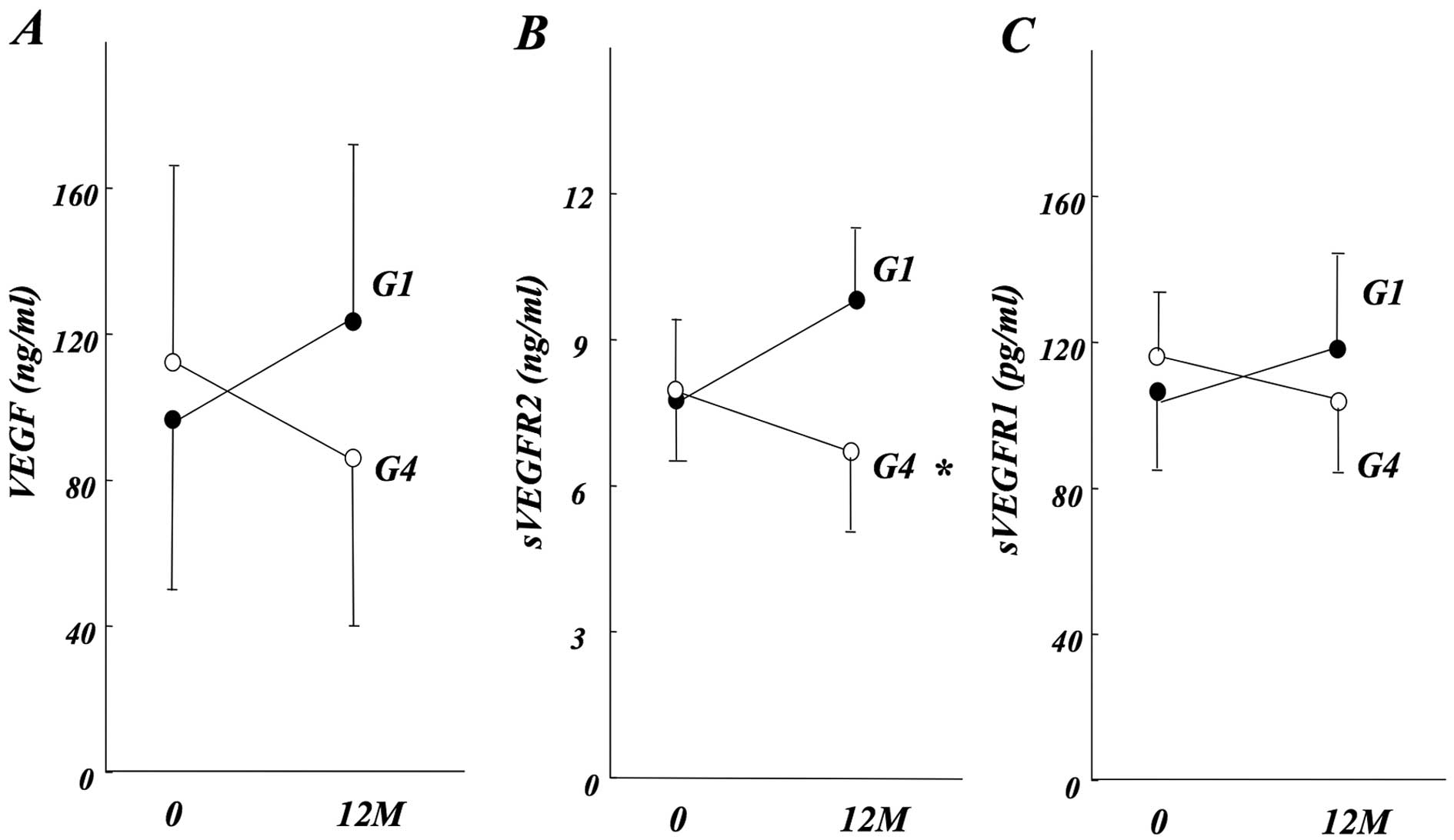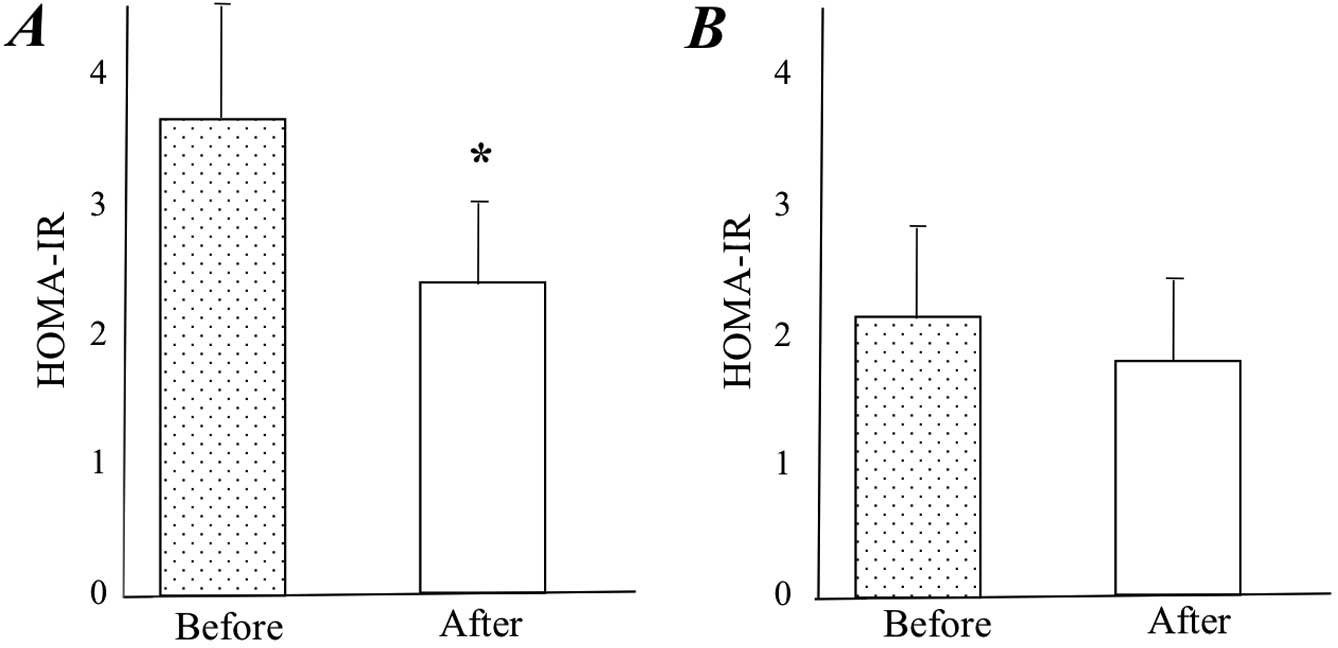Introduction
Hepatocellular carcinoma (HCC) is now one of the
major health problems worldwide. HCC is the sixth most common cause
of cancer-related mortality. Patients with liver cirrhosis are at
the highest risk of developing HCC (1). One of the reasons for the poor
prognosis of HCC is its high rate of recurrence regardless of its
etiology such as hepatitis virus C (HCV). Increasing evidence
indicates that the high rate of recurrence, even after local
curative therapy, is due to intrahepatic metastasis or
multi-centric development of each respective neoplasm clone. Since
the high-risk group of either primary or secondary HCC development
appears to be clearer than the other types of tumors, it is likely
that chemopreventive agents should be beneficial for improving the
prognosis of HCC.
Any solid tumor including HCC that has not acquired
its own new blood supply cannot grow to more than a few millimeters
in size (2,3). Several studies have shown that
neovascularization and angiogenic factors, such as vascular
endothelial cell growth factor (VEGF), are significantly
upregulated in human HCC samples (4–6). It
has recently been reported that angiogenesis may be induced at the
early stages of tumor formation and carcinogenesis (7–10). We
previously demonstrated that angiogenesis was increased in a
stepwise manner during the murine hepatocarcinogenesis process and
that suppression of the VEGF signaling pathway markedly attenuated
hepatocarcinogenesis (11). It has
been reported that alterations of the hepatic microcirculation in
the human liver occurs at an early stage of liver carcinogenesis in
association with hepatic cellular changes or within the dysplastic
nodules before the emergence of morphologically identifiable HCC
(12).
Cross-sectional human studies have shown that
insulin resistance (IR) (i.e., co-existence of high blood glucose
and insulin levels) is a consistent finding in patients with type 2
diabetes mellitus (DM), and a close interaction between DM and HCC
has been documented (13). DM is
associated with a 2- to 3-fold increase in the risk of HCC
regardless of the etiology of chronic liver disease (14,15).
Experimental evidence for the contribution of HCV in the
development of IR and DM has been found in an HCV-transgenic mouse
model (16). Moreover, several
human studies have demonstrated that IR is an HCC risk factor in
patients with chronic hepatitis C (CHC) (17) and a similar close interaction was
observed in patients with other morbidities, such as non-alcoholic
fatty liver diseases (NAFLD) (18).
The branched-chain amino acids (BCAAs) are comprised
of three essential amino acids: namely, leucine, iso-leucine and
valine. Recent studies have shown that BCAA granules improved the
nutritional status (e.g. hypoalbuminemia) and event-free survival
in patients with liver cirrhosis (19,20).
Furthermore, BCAAs were found to suppress the incidence of
hepatocarcinogenesis in patients with HCV-related cirrhosis and
obesity that is often associated with IR (21). BCAAs are also known to modulate
insulin signaling. They induce glucose uptake and improve glucose
metabolism in rats with liver cirrhosis (22,23).
They also improve IR in patients with HCV-related liver diseases
(24,25). Previously, we reported that IR
itself significantly augmented VEGF-mediated hepatic
neovascularization (26). We
reported that BCAAs exert a chemopreventive effect against HCC
along with suppression of VEGF expression and hepatic
neovascularization in obese diabetic rats with IR (27). In contrast to the animal studies,
single BCAA treatment failed to suppress the first and second
recurrence of HCC after local curative therapy in clinical practice
(28). However, this study was
focused on the whole recurrence rate of HCC in patients with low
albuminemia [serum albumin (Alb) level of <3.5] and not with or
without IR.
In the present study, we examined whether or not
BCAAs suppress disease recurrence in patients with HCC under the IR
condition after they had received local curative therapy and the
possible mechanisms involved.
Materials and methods
Patients and treatment
This study was conducted on 93 patients with HCC who
were admitted to our hospital for treatment against HCC. Our first
and second endpoint consisted of the effect of BCAAs on cumulative
recurrence and overall survival, respectively. The number of
patients in each group was based on previous studies. We previously
reported that the combination of vitamin K (VK) and
angiotensin-converting enzyme inhibitor (ACE-I) ameliorated the
cumulative recurrence of HCC in 25 patients in each group (29). Similarly, another report showed the
role of VK in the development of HCC in 25 patients in each group
(17). We referred to these studies
to determine the suitable number of patients in the present study.
HCC was diagnosed with a combination of several imaging modalities:
namely, ultrasonography (US), computer tomography (CT), magnetic
resonance imaging (MRI) and hepatic angiography. The diagnosis of
HCC was based on the 2005 diagnostic algorithm by the American
Association for the Study of Liver Diseases (30,31).
All lesions were hypervascular. By CT scan analysis,
hyperattenuation was observed during the arterial phase in the
entire portion of the tumor and hypoattenuation in the
portal-venous phase. Since we did not encounter any unusual lesions
that required needle biopsy for histological confirmation, we did
not have any histological proof of the diagnosis of our patients.
All patients received local curative therapy with percutaneous
radiofrequency ablation (RFA) for prior HCC and were confirmed free
of any residual HCC by several imaging modalities. The IR index was
calculated on the basis of fasting values for glycemia and
insulinemia according to the homeostasis model assessment (HOMA)-IR
method as described previously (32). The clinical profiles, laboratory
data and characteristics of the patients are shown in Table I. We recommended all patients to
strictly stop alcohol intake. Until the end of the follow-up for
recurrence, no patients received any additional therapy for HCC,
such as interferon (IFN). All patients provided written informed
consent before participating in this study. The study protocol was
approved by the Institutional Review Board (IRB) of Nara Medical
University (NMU06-003), and the study was conducted in conformance
with ethical and humane principles, as well as the Helsinki
declaration. The patients were randomly (using sealed envelopes)
divided into either the control group or the BCAA-treated group. No
placebo was used in the control group. The patients in the
BCAA-treated group were given oral BCAA granules
(Livact®, 12 g/day) continuously for 60 months,
according to standard clinical practice. We assessed the BCAA
adherence by questionnaire at each visit to the hospital. Since the
adherence rate was more than 80% in all patients, we included all
patients for analysis. We also divided the control patients into
two subgroups according to HOMA-IR, immune reactive insulin (IRI)
and fasting blood sugar (FBS), which were identical to the
BCAA-treated groups.
 | Table IDemographic characteristics of the
enrolled patients. |
Table I
Demographic characteristics of the
enrolled patients.
|
Characteristics | Untreated
control | BCAA | P-value |
|---|
| No. of
patients | 42 | 51 | |
| Agea (years) | 62.2±14.8 | 63.6±15.3 | 0.408b |
| Gender, n | | | 0.752c |
| Male | 25 | 32 | |
| Female | 17 | 19 | |
| Etiology, n | | | 0.551c |
| HCV | 32 | 36 | |
| HBV | 6 | 9 | |
| Other | 4 | 6 | |
| Alcohol intake
(g/day), n | | | 0.648c |
| <40 | 33 | 42 | |
| ≥40 | 9 | 9 | |
| Tumor stage, n | | | 0.758c |
| I | 25 | 29 | |
| II | 16 | 20 | |
| III | 1 | 2 | |
| Tumor sizea (mm) | 21.5±9.2 | 22.3±8.9 | 0.409b |
| No. of
tumorsa | 1.74±1.18 | 1.84±0.96 | 0.082b |
| AFPa (ng/ml) | 81.8±176.5 | 84.4±186.8 | 0.349b |
| PIVKA-IIa (mAU/ml) | 70.1±72.3 | 68.6±70.9 | 0.444b |
| ALTa (IU/l) | 70.3±34.3 | 72.2±34.9 | 0.449b |
| Alba (g/dl) | 3.61±1.11 | 3.57±1.20 | 0.298b |
| HOMA-IRa | 2.64±2.56 | 3.20±2.88 | 0.212b |
| IRIa (U/ml) | 12.34±7.33 | 14.58.±12.42 | 0.754b |
| FBSa (mg/dl) | 101.4±27.2 | 97.8±31.2 | 0.176b |
| Child-Pugh, n | | | 0.829c |
| A | 33 | 41 | |
| B | 9 | 10 | |
Study design
In the present study, we employed therapeutic
modalities according to the algorithm of HCC treatment by the Liver
Cancer Study Group of Japan (LCSGJ). In this algorithm, the
therapeutic strategy is chosen based on the degree of liver damage
as determined by LCSGJ and the characteristics of the tumor itself.
The indications of RFA of LCSGJ are: i) three or fewer tumors
measuring 3 cm or less, or ii) a solitary tumor with a major axis
of 5 cm or less. In our university, an inter-departmental
conference is held every week. We discuss the selection of
therapeutic modalities with surgeons and radiologists for each HCC
case. When RFA is selected in this conference, the patient is
admitted to our department. After RFA, follow-up was conducted
using enhanced CT and US (CECT and CEUS, respectively) once a month
for the first three months. Regarding the safety margin, we set a
5-mm safety margin for all sides of the tumor for RFA. After one
week, we confirmed the therapeutic effect by CEUS. If any viable
HCC was detected during this period, we excluded it from the
present study as non-local curative ablation by RFA. In the present
study, we did not divide the patients by recurrent lesions. After
the first three monthly observations, we included the HCC
recurrence rate even when the recurrence occurred in the same
lesion as the previous treatment.
To identify the recurrent HCC nodules, imaging
studies such as US and CT were performed every 3 months. The serum
tumor markers, namely, α-fetoprotein (AFP) and
des-γ-carboxyprothrombin (PIVKA-II), were measured every 2 months
using routine laboratory methods. Prior to and at 12 months after
starting drug administration, alterations in angiogenic factors
were evaluated using a TranSignal Angiogenesis Antibody Array
(Panomics, Inc., Redwood City, CA, USA) in serum according to the
manufacturer’s manual after the equalization of the protein
content. We also examined alterations in VEGF (33), sVEGFR1 and sVEGFR2 in serum using an
enzyme-linked immunosorbent assay (ELISA) kit (R&D Systems)
according to the manufacturer’s instructions as described
previously (11). When any
recurrence was detected, the patient was excluded from the protocol
and immediately treated for secondary HCC according to the LCSGJ
algorithm. In the current study, all recurrent cases met the
aforementioned RFA criteria. Accordingly, all patients with first
recurrence were treated with RFA. Nevertheless, several patients
with secondary recurrence received transarterial chemoembolization
(TACE) and/or arterial infusion chemotherapy afterward. Liver
transplantation is uncommon in Japan for patients with recurrent
HCC.
Statistical analysis
The variables of the characteristics of the enrolled
patients were analyzed by the Mann-Whitney U test and the Fisher
exact probability test. The cumulative recurrence of HCC was
plotted using the Kaplan-Meier method, and the differences in the
recurrence curves were tested using the log-rank test.
Results
Patient characteristics
The characteristics of the enrolled patients are
documented in Table I. There were
no significant differences among the patients of all groups in
regards to age, gender, etiology of the disease and background
liver function (Child-Pugh score). In addition, the tumor baseline,
such as stage, number of tumors, AFP and PIVKA-II levels did not
differ among the groups. BCAAs are widely used without serious
adverse effects, and the safety of their long-term administration
has been proven in clinical practice. In the present study, there
were no severe toxic effects in any groups, and no abnormal
laboratory data were found that could likely be related to the BCAA
treatment. Accordingly, after randomization, we followed up all
enrolled patients in each group until the detection of recurrence.
We analyzed the demographic characteristics of all subgroups
including HOMA-IR, IRI and FBS. There were no statistically
significant differences. We also checked the unintentional increase
in γ-GTP and the alteration in marked body weight. We observed that
there was no significant difference among all groups.
HCC recurrence
The results of the BCAA treatment are shown in
Fig. 1. The BCAA treatment markedly
inhibited the cumulative recurrence of HCC in patients with high IR
index (HOMA-IR >2.5) as compared with the control group of
patients with HOMA-IR >2.5. On the other hand, no suppressive
effect was observed in the patients with HOMA-IR ≤2.5. Similarly,
BCAA treatment had a marked suppressive effect in the patients with
high fasting insulin (IRI >15 U/ml), but not in patients with
IRI ≤15 as compared with the respective control group (Fig. 2). We observed that there were no
significant differences in the alanine transaminase (ALT) levels
between the control and BCAA-treated groups, indicating that the
suppressive effect of BCAAs on the cumulative recurrence was not
due to cytoprotective activity. Although the primary end-point of
the current study was the cumulative recurrence rates, we also
examined whether or not the survival curves of the patients were
altered during the follow-up period as a second endpoint. We found
no statistical differences between both groups (data not shown). In
contrast to those of HOMA-IR and IRI, BCAA treatment did not show
any differences in HCC recurrence between patients with high and
low glucose levels (FBS >110 and ≤110, respectively) when
compared to the respective control group (Fig. 3). We next performed subanalysis to
examine whether BCAA exerts different effects on Alb levels under
the IR condition. As shown in Fig.
4, BCAAs showed a significant suppressive effect on HCC
recurrence regardless of the Alb levels (both serum Alb >3.5 and
≤3.5). All groups exerted 5–8% treatment-site local recurrence.
However, there were no significant differences in the recurrence
rate in each group in the current analysis.
Plasma levels of VEGF-related factors and
IR
Since VEGF expression is predominantly altered by
BCAA treatment (34), we measured
the expression levels of VEGF-related molecules by ELISA in all
patients. The serum VEGF level in the control group increased after
12 months whereas following BCAA treatment, the patients with high
HOMA-IR attenuated VEGF level when compared to the pretreatment
level, although it was not significant (Fig. 5A). We also elucidated the expression
levels of the soluble forms of VEGF receptor R1 and R2 (sVEGFR1 and
sVEGFR2, respectively). As shown in Fig. 5B, sVEGFR2 was markedly decreased by
BCAA treatment whereas the serum level of sVEGFR2 in the control
group increased. In contrast, there were no significant differences
in sVEGFR1 between the pretreatment and post-treatment levels in
both groups (Fig. 5C).
We also examined the alteration of the IR status by
the HOMA-IR score. As shown in Fig.
6A, the treatment with BCAAs for 12 months significantly
decreased the median HOMA-IR score in the patients with high
HOMA-IR, although no marked differences were observed in patients
with low HOMA-IR.
Discussion
In the present study, we found that treatment with
the clinically used BCAA formula markedly inhibited the cumulative
HCC recurrence after local curative therapy under the condition of
high HOMA-IR along with suppression of several indices. It is
well-known that the IR status in patients with chronic liver
diseases is usually associated with both high insulin and glucose
levels (35). We previously
reported that the IR status itself significantly augmented
hepatocarcinogenesis (26) and
BCAAs could suppress the development of pre-neoplastic lesions
under the IR condition in rats (27). Accordingly, in the present study, we
observed that BCAAs suppressed the recurrence of HCC in the
patients with high IRI while glucose levels were not influence by
the effect of BCAA treatment. A recent report showed that BCAAs
suppressed insulin-induced hepatic tumor cell proliferation
(36). We observed that IR was
significantly improved by the BCAA treatment. This effect is also
likely to play a clinically beneficial role since insulin is now
recognized as a multi-functional protein involved in tumor cell
proliferation and anti-apoptotic activity (26). These results indicate that the
suppressive effect of BCAAs was, at least partly, mediated by the
inhibition of insulin-induced HCC progression rather than
glucose-induced effects.
BCAAs are known to exert multiple pharmacological
activities (37,38). We observed that the inhibitory
effect of BCAAs was correlated with a decrease in the angiogenic
factor. We previously reported that BCAAs suppress VEGF expression
during hepatocarcinogenesis in rats under the IR condition
(27,39). IR itself has been shown to augment
neovascularization (26). Recently,
it has also been reported that BCAAs inhibit insulin-induced
expression of VEGF by decreasing the stability of insulin-induced
VEGF mRNA (40). We previously
reported that VEGF and VEGFR2 interaction plays a pivotal role in
HCC growth and hepatocarcinogenesis (11,41).
It has been reported that the circulating sVEGFR2 level may provide
insight into VEGFR2 activation (42). In renal cell carcinoma, the sVEGFR2
levels were significantly decreased by treatment with sunitinib,
which is a multi-kinase inhibitor, including VEGFR, during the
treatment cycle 1 (43). Moreover,
the levels tended to return to near baseline after a 2-week
treatment, indicating that sVEGFR2 was possibly a sensitive marker
of anti-angiogenic therapy. These results indicate that BCAAs
suppress VEGF and VEGFR2 interaction, and sVEGFR2 may be utilized
as a useful clinical predictive marker for BCAA treatment under the
IR condition. sVEGFR1 is the product of alternative mRNA splicing
and is composed of only 6 of 7 immunoglobulin-like domains. sVEGFR1
is also reportedly a potential surrogate marker for disease
progression in several types of cancers such as breast cancer and
renal cell carcinoma. In HCC, it has been found that sVEGFR1 is
correlated with poor prognosis although it is not an independent
prognostic factor for HCC (44). In
the present study, we did not find any significant correlation
between sVEGFR1 alteration and HCC recurrence.
Although the primary end-point of the present study
was the cumulative recurrence rates, we also examined whether or
not the survival curves of the patients were altered during the
follow-up period. No statistical differences were found among the
groups (data not shown). Since the follow-up period in the present
study was probably not long enough, no statistical differences were
detected among the groups. Further long-term and large-scale
studies are also required to verify whether or not the suppressive
effect of BCAA on the cumulative recurrence will improve
prognosis.
In addition, the inhibitory effect of single
treatment of BCAAs seemed contradictory to our previous results
(34). We previously reported that
the single treatment of BCAAs could not exert enough inhibitory
effect on HCC recurrence. The exact reason for this discrepancy is
not clear at this time, however, the definition of IR may be one of
the reasons. In the previous study, we defined IR with high
insulinogenic-index by 75 g oral glucose tolerance test as well as
HOMA-IR. The mechanism of IR in patients with chronic liver disease
is known to be complicated (35).
It has also been reported that BCAAs exert favorable effects on IR
in several organs such as the liver, skeletal muscles and the
adipose tissues (37,38). It is possible that the reaction of
each tissue regarding IR improvement following BCAA treatment was
different from the previous report. Further studies are required to
elucidate the exact mechanism using large-scale clinical
trials.
In conclusion, we showed that BCAA treatment
significantly attenuates the cumulative recurrence of HCC for 60
months after local curative therapy under the IR condition along
with suppression of several indices, such as VEGF, sVEGFR2 and
HOMA-IR. These results indicate that BCAAs may represent a new
anti-angiogenic strategy for secondary chemoprevention against HCC
since BCAAs are widely used in clinical practice without serious
side effects. Moreover, sVEGFR2 is a useful clinical predictive
marker for BCAA treatment against HCC recurrence under IR
conditions.
Abbreviations:
|
AFP
|
α-fetoprotein
|
|
BCAA
|
branched-chain amino acid
|
|
EC
|
endothelial cells
|
|
FBS
|
fasting blood sugar
|
|
HOMA-IR
|
homeostasis model assessment-IR
|
|
IRI
|
immune reactive insulin
|
|
HCC
|
hepatocellular carcinoma
|
|
IR
|
insulin resistance
|
|
RFA
|
percutaneous radiofrequency
ablation
|
|
VEGF
|
vascular endothelial growth factor
|
References
|
1
|
Forner A, Llovet JM and Bruix J:
Hepatocellular carcinoma. Lancet. 379:1245–1255. 2012. View Article : Google Scholar
|
|
2
|
Kerbel RS: Tumor angiogenesis: past,
present and the near future. Carcinogenesis. 21:505–515. 2000.
View Article : Google Scholar : PubMed/NCBI
|
|
3
|
Shojaei F: Anti-angiogenesis therapy in
cancer: current challenges and future perspectives. Cancer Lett.
320:130–137. 2012. View Article : Google Scholar : PubMed/NCBI
|
|
4
|
Guo RP, Zhong C, Shi M, et al: Clinical
value of apoptosis and angiogenesis factors in estimating the
prognosis of hepatocellular carcinoma. J Cancer Res Clin Oncol.
132:547–555. 2006. View Article : Google Scholar : PubMed/NCBI
|
|
5
|
Iavarone M, Lampertico P, Iannuzzi F, et
al: Increased expression of vascular endothelial growth factor in
small hepatocellular carcinoma. J Viral Hepat. 14:133–139. 2007.
View Article : Google Scholar : PubMed/NCBI
|
|
6
|
Dufour JF: Anti-angiogenic therapy for
HCC. Minerva Gastroenterol Dietol. 58:81–86. 2012.PubMed/NCBI
|
|
7
|
Li CY, Shan S, Huang Q, et al: Initial
stages of tumor cell-induced angiogenesis: evaluation via skin
window chambers in rodent models. J Natl Cancer Inst. 92:143–147.
2000. View Article : Google Scholar
|
|
8
|
Bergers G and Benjamin LE: Tumorigenesis
and the angiogenic switch. Nat Rev Cancer. 3:401–410. 2003.
View Article : Google Scholar
|
|
9
|
Bergers G, Javaherian K, Lo KM, Folkman J
and Hanahan D: Effects of angiogenesis inhibitors on multistage
carcinogenesis in mice. Science. 284:808–812. 1999. View Article : Google Scholar : PubMed/NCBI
|
|
10
|
Brandvold KA, Neiman P and Ruddell A:
Angiogenesis is an early event in the generation of myc-induced
lymphomas. Oncogene. 19:2780–2785. 2000. View Article : Google Scholar : PubMed/NCBI
|
|
11
|
Yoshiji H, Kuriyama S, Yoshii J, et al:
Halting the interaction between vascular endothelial growth factor
and its receptors attenuates liver carcinogenesis in mice.
Hepatology. 39:1517–1524. 2004. View Article : Google Scholar
|
|
12
|
Frachon S, Gouysse G, Dumorti J, et al:
Endothelial cell marker expression in dysplastic lesions of the
liver: an immunohistochemical study. J Hepatol. 34:850–857. 2001.
View Article : Google Scholar : PubMed/NCBI
|
|
13
|
Kahn CR: Insulin resistance, insulin
insensitivity, and insulin unresponsiveness: a necessary
distinction. Metabolism. 27:1893–1902. 1978. View Article : Google Scholar : PubMed/NCBI
|
|
14
|
Davila JA, Morgan RO, Shaib Y, McGlynn KA
and El-Serag HB: Diabetes increases the risk of hepatocellular
carcinoma in the United States: a population based case control
study. Gut. 54:533–539. 2005. View Article : Google Scholar : PubMed/NCBI
|
|
15
|
El-Serag HB, Tran T and Everhart JE:
Diabetes increases the risk of chronic liver disease and
hepatocellular carcinoma. Gastroenterology. 126:460–468. 2004.
View Article : Google Scholar : PubMed/NCBI
|
|
16
|
Shintani Y, Fujie H, Miyoshi H, et al:
Hepatitis C virus infection and diabetes: direct involvement of the
virus in the development of insulin resistance. Gastroenterology.
126:840–848. 2004. View Article : Google Scholar : PubMed/NCBI
|
|
17
|
Habu D, Shiomi S, Tamori A, et al: Role of
vitamin K2 in the development of hepatocellular carcinoma in women
with viral cirrhosis of the liver. JAMA. 292:358–361. 2004.
View Article : Google Scholar : PubMed/NCBI
|
|
18
|
Bugianesi E, McCullough AJ and Marchesini
G: Insulin resistance: a metabolic pathway to chronic liver
disease. Hepatology. 42:987–1000. 2005. View Article : Google Scholar : PubMed/NCBI
|
|
19
|
Marchesini G, Bianchi G, Merli M, et al:
Nutritional supplementation with branched-chain amino acids in
advanced cirrhosis: a double-blind, randomized trial.
Gastroenterology. 124:1792–1801. 2003. View Article : Google Scholar : PubMed/NCBI
|
|
20
|
Muto Y, Sato S, Watanabe A, et al: Effects
of oral branched-chain amino acid granules on event-free survival
in patients with liver cirrhosis. Clin Gastroenterol Hepatol.
3:705–713. 2005. View Article : Google Scholar : PubMed/NCBI
|
|
21
|
Muto Y, Sato S, Watanabe A, et al:
Overweight and obesity increase the risk for liver cancer in
patients with liver cirrhosis and long-term oral supplementation
with branched-chain amino acid granules inhibits liver
carcinogenesis in heavier patients with liver cirrhosis. Hepatol
Res. 35:204–214. 2006.PubMed/NCBI
|
|
22
|
Nishitani S, Ijichi C, Takehana K,
Fujitani S and Sonaka I: Pharmacological activities of
branched-chain amino acids: specificity of tissue and signal
transduction. Biochem Biophys Res Commun. 313:387–389. 2004.
View Article : Google Scholar : PubMed/NCBI
|
|
23
|
Nishitani S, Takehana K, Fujitani S and
Sonaka I: Branched-chain amino acids improve glucose metabolism in
rats with liver cirrhosis. Am J Physiol Gastrointest Liver Physiol.
288:G1292–G1300. 2005. View Article : Google Scholar : PubMed/NCBI
|
|
24
|
Kawaguchi T, Taniguchi E, Itou M, et al:
Branched-chain amino acids improve insulin resistance in patients
with hepatitis C virus-related liver disease: report of two cases.
Liver Int. 27:1287–1292. 2007.PubMed/NCBI
|
|
25
|
Kawaguchi T, Nagao Y, Matsuoka H, Ide T
and Sata M: Branched-chain amino acid-enriched supplementation
improves insulin resistance in patients with chronic liver disease.
Int J Mol Med. 22:105–112. 2008.PubMed/NCBI
|
|
26
|
Kaji K, Yoshiji H, Kitade M, et al: Impact
of insulin resistance on the progression of chronic liver diseases.
Int J Mol Med. 22:801–808. 2008.PubMed/NCBI
|
|
27
|
Yoshiji H, Noguchi R, Kitade M, et al:
Branched-chain amino acids suppress insulin-resistance-based
hepatocarcinogenesis in obese diabetic rats. J Gastroenterol.
44:483–491. 2009. View Article : Google Scholar : PubMed/NCBI
|
|
28
|
Tsuchiya K, Asahina Y, Sato T, et al: Oral
supplementation with branched-chain amino acid (BCAA) improves
survival and decreases the third time recurrence after successful
treatment of hepatocellular carcinoma (HCC). J Hepatol (EASL
proceeding). (48 suppl)2:S1602009.
|
|
29
|
Yoshiji H, Noguchi R, Toyohara M, et al:
Combination of vitamin K2 and angiotensin-converting enzyme
inhibitor ameliorates cumulative recurrence of hepatocellular
carcinoma. J Hepatol. 51:315–321. 2009. View Article : Google Scholar
|
|
30
|
Bruix J and Sherman M: Management of
hepatocellular carcinoma. Hepatology. 42:1208–1236. 2005.
View Article : Google Scholar
|
|
31
|
Bruix J and Sherman M: Diagnosis of small
HCC. Gastroenterology. 129:13642005. View Article : Google Scholar : PubMed/NCBI
|
|
32
|
Fartoux L, Poujol-Robert A, Guéchot J,
Wendum D, Poupon R and Serfaty L: Insulin resistance is a cause of
steatosis and fibrosis progression in chronic hepatitis C. Gut.
54:1003–1008. 2005. View Article : Google Scholar : PubMed/NCBI
|
|
33
|
Ferrara N: VEGF as a therapeutic target in
cancer. Oncology. 69:11–16. 2005. View Article : Google Scholar
|
|
34
|
Yoshiji H, Noguchi R, Ikenaka Y, et al:
Combination of branched-chain amino acids and
angiotensin-converting enzyme inhibitor suppresses the cumulative
recurrence of hepatocellular carcinoma: a randomized control trial.
Oncol Rep. 26:1547–1553. 2011.
|
|
35
|
Kaji K, Yoshiji H, Ikenaka Y, et al:
Possible involvement of angiogenesis in chronic liver diseases:
interaction among renin-angiotensin-aldosterone system, insulin
resistance and oxidative stress. Curr Med Chem. 19:1889–1898. 2012.
View Article : Google Scholar
|
|
36
|
Hagiwara A, Nishiyama M and Ishizaki S:
Branched-chain amino acids prevent insulin-induced hepatic tumor
cell proliferation by inducing apoptosis through mTORC1 and
mTORC2-dependent mechanisms. J Cell Physiol. 227:2097–2105. 2012.
View Article : Google Scholar
|
|
37
|
Kawaguchi T, Izumi N, Charlton MR and Sata
M: Branched-chain amino acids as pharmacological nutrients in
chronic liver disease. Hepatology. 54:1063–1070. 2011. View Article : Google Scholar : PubMed/NCBI
|
|
38
|
Shimizu M, Kubota M, Tanaka T and Moriwaki
H: Nutraceutical approach for preventing obesity-related colorectal
and liver carcinogenesis. Int J Mol Sci. 13:579–595. 2012.
View Article : Google Scholar : PubMed/NCBI
|
|
39
|
Yoshiji H, Noguchi R, Kaji K, et al:
Attenuation of insulin-resistance-based hepatocarcinogenesis and
angiogenesis by combined treatment with branched-chain amino acids
and angiotensin-converting enzyme inhibitor in obese diabetic rats.
J Gastroenterol. 45:443–450. 2010. View Article : Google Scholar
|
|
40
|
Miuma S, Ichikawa T, Arima K, et al:
Branched-chain amino acid deficiency stabilizes insulin-induced
vascular endothelial growth factor mRNA in hepatocellular carcinoma
cells. J Cell Biochem. 113:3113–3121. 2012. View Article : Google Scholar
|
|
41
|
Yoshiji H, Kuriyama S, Yoshii J, et al:
Synergistic effect of basic fibroblast growth factor and vascular
endothelial growth factor in murine hepatocellular carcinoma.
Hepatology. 35:834–842. 2002. View Article : Google Scholar : PubMed/NCBI
|
|
42
|
Wierzbowska A, Robak T, Wrzesień-Kuś A,
Krawczyńska A, Lech-Marańda E and Urbańska-Ryś H: Circulating VEGF
and its soluble receptors sVEGFR-1 and sVEGFR-2 in patients with
acute leukemia. Eur Cytokine Netw. 14:149–153. 2003.PubMed/NCBI
|
|
43
|
Deprimo SE, Bello CL, Smeraglia J, et al:
Circulating protein biomarkers of pharmacodynamic activity of
sunitinib in patients with metastatic renal cell carcinoma:
modulation of VEGF and VEGF-related proteins. J Transl Med.
5:322007. View Article : Google Scholar : PubMed/NCBI
|
|
44
|
Nagaoka S, Yoshida T, Akiyoshi J, et al:
The ratio of serum placenta growth factor to soluble vascular
endothelial growth factor receptor-1 predicts the prognosis of
hepatocellular carcinoma. Oncol Rep. 23:1647–1654. 2010.
|















